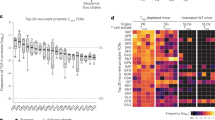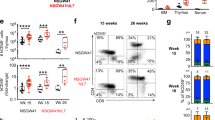Abstract
T lymphocytes differentiate and mature in the thymus. It is here that thymocytes with reactivities to self antigens are eliminated and those with specificities to ‘altered’ self-major histocompatibility complex (MHC) gene products are positively selected1. The selections are presumably carried out on the basis of their T-cell antigen receptors (TcR). The genes of the α- and β-chain T-cell antigen receptors have been cloned2–7. A third T-cell specific gene capable of undergoing somatic rearrangement has also been identified8; the role of this third gene is not known. An order of expression of γ, β, then α is found during T-cell ontogeny9,10. But although α- and β-chain messages are often functional11–15, γ transcripts are rarely functional in thymocytes or mature T cells16–18. To define the sequential order of expression of these genes further and to continue the search for a possible role for the TcR γ gene products, we investigated the expression of ‘functional’ α-, β- and γ-chain transcripts in young athymic mice. These mice express an undetectable amount (less than one in 8 × l05 spleen messages) of ‘full-length’ α- and β-chain T-cell receptor transcripts, but an increased level of expression of ‘full-length’ γ chain messages. Nucleotide sequence analysis of four γ complementary DNAs show that all four γ transcripts sequenced are functional. These findings suggest that γ gene products may be important in a prethymic or extrathymic pathway and may represent a second type of T-cell recognition, possibly in a lineage in which α and β genes are not used.
This is a preview of subscription content, access via your institution
Access options
Subscribe to this journal
Receive 51 print issues and online access
$199.00 per year
only $3.90 per issue
Buy this article
- Purchase on Springer Link
- Instant access to full article PDF
Prices may be subject to local taxes which are calculated during checkout
Similar content being viewed by others
References
Zinkernagel, R. M. & Doherty, P. C. Adv. Immun. 27, 51–77 (1979).
Yanagi, Y. et al. Nature 308, 145–149 (1984).
Hedrick, S., Cohen, D., Nielson, E. & Davis, M. Nature 308, 149–153 (1984).
Saito, H. et al. Nature 312, 36–40 (1984).
Chien, Y.-H. et al. Nature 312, 31–35 (1984).
Sim, G. K. et al. Nature 312, 771–774 (1984).
Yanagi, Y. et al. Proc. natn. Acad. Sci. U.S.A. 82, 3430–3434 (1985).
Saito, H. et al. Nature 309, 757–762 (1984).
Raulet, D., Garman, R., Saito, H. & Tonegawa, S. Nature 314, 103–107 (1985).
Snodgrass, H. P., Dembic, Z., Steinmetz, M. & von Boehmer, H. Nature 315, 232–233 (1985).
Barth, R. K. et al. Nature 316, 517–523 (1985).
Behlke, M. A. et al. Science 229, 566–570 (1985).
Arden, B., Klotz, J. L., Siu, G. & Hood, L. E. Nature 316, 783–787 (1985).
Yoshikai, Y., Kimura, N., Toyonaga, B. & Mak, T. W. J. exp. Med. 164, 90–103 (1986).
Kimura, N. et al. J. exp. Med. 164, 739–750 (1986).
Rupp, F. et al. Nature 321, 876–878 (1986).
Reilly, E. B., Kranz, D. M., Tonegawa, S. & Eisen, H. N. Nature 321, 878–880 (1986).
Yoshikai, Y. et al. Eur. J. Immun. (in the press).
MacDonald, R. H. et al. J. Immun. 126, 865–870 (1981).
Julius, M. H., Simpson, E. & Herzenberg, L. A. Eur. J. Immun. 3, 645–649 (1973).
Siu, G. et al. Nature 311, 344–348 (1984).
Clark, S. P. et al. Nature 311, 387–389 (1984).
Yoshikai, Y. et al. Nature 312, 521–524 (1984).
Heilig, J. S. & Tonegawa, S. Nature 322, 836–840 (1986).
Hunig, T. in T Lymphocytes Today (ed. Inglis, J. R.) 42–45 (Elsevier, Amsterdam, 1983).
Kranz, D. M. et al. Nature 313, 752–755 (1985).
Zuderer, M., Iwamoto, A. & Mak, T. W. J. exp. Med. 163, 1314–1318 (1986).
Dembic, Z. et al. Nature 320, 233–238 (1986).
Chirgmin, J. M., Przybyla, A. E., MacDonald, R. J. & Rutter, W. J. Biochemistry 18, 5294–5299 (1979).
Gubier, V. & Hoffman, B. J. Gene 25, 263–269 (1983).
Sanger, F., Nicklen, S. & Coulson, A. R. Proc. natn. Acad. Sci. U.S.A. 74, 5463–5467 (1977).
Strauss, E. C., Kobori, J. A., Siu, G. & Hood, L. Analyt. Biochem. 154, 353–360 (1986).
Iwamoto, A. et al. J exp. Med. (submitted).
Iwamoto, A. et al. J. exp. Med. 163, 1203–1212 (1986).
Owen, M. J. et al Eur. J. Immun. 16, 875–878 (1966).
Brener, M. et al. Nature 322, 145–149 (1986).
Bank, I. et al. Nature 322, 179–181 (1986).
Weiss, A., Newton, M. & Crommie, D. Proc. natn. Acad. Sci. U.S.A. 83, 6988–7002 (1986).
Author information
Authors and Affiliations
Rights and permissions
About this article
Cite this article
Yoshikai, Y., Reis, M. & Mak, T. Athymic mice express a high level of functional γ-chain but greatly reduced levels of α- and β-chain T-cell receptor messages. Nature 324, 482–485 (1986). https://doi.org/10.1038/324482a0
Received:
Accepted:
Issue Date:
DOI: https://doi.org/10.1038/324482a0
This article is cited by
-
Acquired and natural memory T cells join forces at the mucosal front line
Nature Reviews Immunology (2004)
-
Thymus-independent expansion of T lymphocytes in children after allogeneic bone marrow transplantation
Bone Marrow Transplantation (2000)
-
Heat-shock proteins and immunopathology: Regulatory role of heat-shock protein-specific T cells
Springer Seminars in Immunopathology (1991)
-
The role ofγδ T cells in the normal and disordered immune system
Klinische Wochenschrift (1990)
-
Expression of the γ-δ T-cell receptor on intestinal CD8+ intraepithelial lymphocytes
Nature (1988)
Comments
By submitting a comment you agree to abide by our Terms and Community Guidelines. If you find something abusive or that does not comply with our terms or guidelines please flag it as inappropriate.



